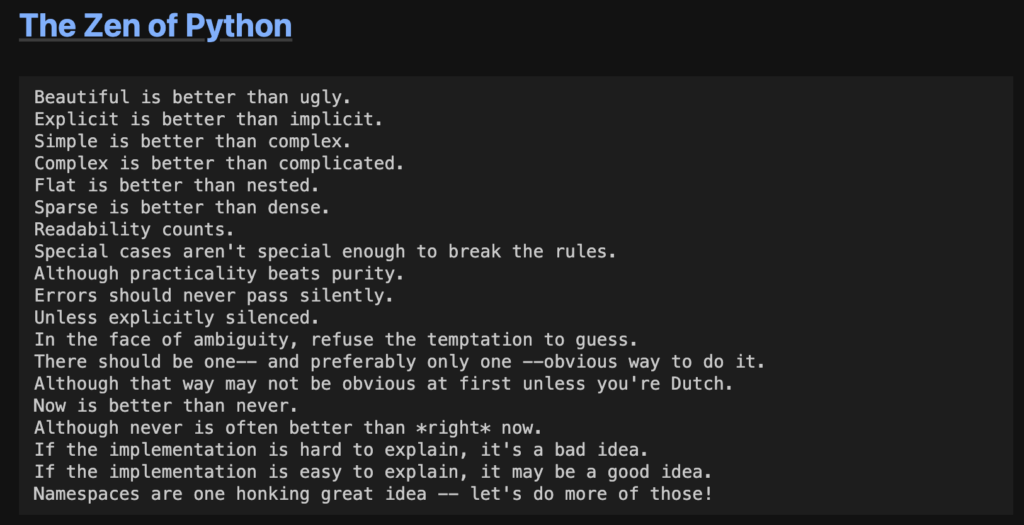Your cart is currently empty!
What is Zen of Python: Python For AI Explained
Author:
Published:
Updated:

The Zen of Python, also known as PEP 20, is a collection of 19 “guiding principles” for writing computer programs that influence the design of the Python programming language. These principles, while not set in stone, provide a philosophical framework for Python development and are a valuable resource for understanding why Python is the way it is, especially in the context of Artificial Intelligence (AI).
Python has become one of the most popular languages for AI and machine learning due to its simplicity, flexibility, and the wide range of libraries and frameworks available for AI development. In this article, we will delve into the Zen of Python and how its principles can be applied to AI programming with Python.
Understanding the Zen of Python
The Zen of Python was penned by Tim Peters, a major contributor to the Python language. It’s a list of 19 aphorisms that serve as guiding principles for writing Pythonic code. While they don’t all directly relate to AI, understanding these principles can help you write more efficient and readable AI code in Python.
These principles emphasize simplicity, readability, and the “Pythonic” way of doing things. They can be accessed in the Python interpreter by importing the ‘this’ module. While some of these principles may seem cryptic at first, they each hold a significant place in understanding the philosophy behind Python’s design.
The Aphorisms of the Zen of Python
Let’s take a look at each of the 19 aphorisms and how they can influence your AI programming with Python.

Applying the Zen of Python to AI Programming
Now that we’ve discussed what the Zen of Python is and what its aphorisms mean, let’s discuss how we can apply these principles to AI programming with Python.
Python’s simplicity and readability, as emphasized by the Zen of Python, make it an excellent choice for AI development. AI algorithms can be complex, and Python’s straightforward syntax can help make these algorithms more understandable and easier to work with.
Using Python Libraries for AI
Python’s wide range of libraries and frameworks for AI and machine learning is another reason for its popularity in this field. Libraries like NumPy, Pandas, and Matplotlib, as well as machine learning frameworks like TensorFlow and PyTorch, make it easier to implement complex AI algorithms.
These libraries and frameworks embody the principles of the Zen of Python. They are designed to be simple to use, yet powerful, and they strive to make complex tasks as straightforward as possible. By using these libraries and frameworks, you can focus on the high-level logic of your AI algorithms, rather than getting bogged down in the details of lower-level code.
Writing Pythonic AI Code
Writing Pythonic code means writing code that adheres to the principles of the Zen of Python. This can make your AI code more efficient, easier to read and understand, and more consistent with the rest of the Python community.
For example, using list comprehensions instead of for-loops, using the ‘with’ statement for file handling, and using built-in functions and operators where possible are all ways to write Pythonic AI code.
Examples of Pythonic AI Code
Let’s take a look at some examples of Pythonic AI code, and how they embody the principles of the Zen of Python.

Here’s an example of using a list comprehension to create a list of squares, instead of using a for-loop:
# Non-Pythonic
squares = []
for i in range(10):
squares.append(i ** 2)
# Pythonic
squares = [i ** 2 for i in range(10)]
This example shows how Python’s simple, readable syntax can make your AI code easier to understand and work with. The Pythonic version is not only shorter, but also more readable and easier to understand at a glance.
Using Python’s Built-In Functions
Python’s built-in functions can make your AI code more efficient and easier to read. For example, the ‘map’ function can be used to apply a function to every item in a list, and the ‘filter’ function can be used to filter items in a list based on a condition.
Here’s an example of using the ‘map’ function to apply a function to every item in a list:
# Non-Pythonic
squares = []
for i in range(10):
squares.append(square(i))
# Pythonic
squares = list(map(square, range(10)))
This example shows how using Python’s built-in functions can make your AI code more efficient and easier to read. The Pythonic version is not only shorter, but also more efficient, as the ‘map’ function is generally faster than a for-loop.
Looking for inspiration 📖
- Sam Altman’s secrets on how to generate ideas for any business
- 6 Greg Brockman Secrets on How to Learn Anything – blog
- The secrets behind the success of Mira Murati – finally revealed
- Ideas to Make Money with ChatGPT (with prompts)
- Ilya Sutskever and his AI passion: 7 Deep Dives into his mind
- The “secret” Sam Altman blog post that will change your life
- 4 Life-Changing Lessons we can learn from John McCarthy – one of AI’s Founding Fathers
- Decoding Elon Musk: 5 Insights Into His Personality Type Through Real-Life Examples
Conclusion
The Zen of Python provides a philosophical framework for Python development, and understanding these principles can help you write more efficient and readable AI code in Python. By adhering to these principles, you can write Pythonic AI code that is easier to understand, more consistent with the rest of the Python community, and potentially more efficient.
Python’s simplicity, readability, and wide range of libraries and frameworks make it an excellent choice for AI development. By understanding and applying the principles of the Zen of Python, you can take full advantage of Python’s strengths in your AI programming.


